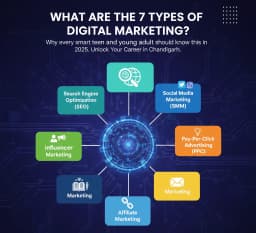
In today’s fast-paced digital landscape, a well-defined digital marketing strategy is crucial for any business aiming to be online. An effective strategy not only helps in reaching potential customers but also ensures marketing efforts align with overall business objectives.
To create an effective digital marketing strategy, you should keep some points in mind that are required to execute your plan properly.
1. Define your goals
The first step in crafting the strategy is to establish clear, measurable goals. These objectives should align with your business aims and can be broken down into several categories:
SMART Goals
-
Specific: Clearly define what you want to achieve. This helps us to achieve our goals without many complications.
-
Measurable: Ensure that your goal can be quantified. Use metrics such as leads generated, conversion rates, or social media engagement.
-
Achievable: Set realistic goals considering your resources and market conditions. Goals must be attainable.
-
Relevant: Align your goals with your business strategy. Each goal should contribute to the business’s mission and vision.
-
Time-bound: Establish a timeline for achieving your goals. This helps in tracking progress and working accordingly.
2. Understand your target audience:
For every business, it’s important to focus on the target audience and create such an effective marketing strategy that helps to gain new customers. Here’s how one can gain a deep understanding of their target audience.
Conduct market research:
The best way to understand your audience is through market research. Utilise surveys, interviews, and focus groups to learn about their preferences, behaviours, and pain points.
Segment Your Audience:
Divide your audience into segments based on demographics(age, gender, income), psychographics (interests, values), and behavioural patterns(purchase history, online habits). This segmentation assists in creating effective marketing campaigns.
Create Buyer Persona:
Create a buyer persona, which includes demographic details, buying behaviour and preferences, and Informational sources.
3. Perform Competitor analysis:
Analysing competitors can add valuable insights into industry trends and help us to cope with those issues. This analysis helps us capture the market easily by understanding how current leaders are running the market.
Identify Competitors:
Compile a list of direct and indirect competition. Look for businesses offering similar products or services or targeting the same audience demographics.
Evaluate their digital presence:
Assess competitors’ websites, social media profiles, content strategies, and online advertising efforts. Tools such as Semrush and Ahrefs can provide data on their traffic, keyword usage, and content effectiveness.
Conduct a SWOT analysis:
This approach will help you understand the strengths, weaknesses, opportunities, and threats of competitors, allowing us to not repeat their mistakes and align with our business goals more effectively.
4. Select Marketing Channels:
Once you’ve defined your goals, audience, and competitive landscape, choose the digital marketing channel that will best serve your strategy. Here are some common channels to consider:
Content marketing:
This can encompass blog posts, articles, infographics, videos, and podcasts. The main aim is to provide solutions to audience pain points while establishing your brand as an authority in the field.
Social Media Marketing:
Platforms such as Facebook, Instagram, and Twitter have their own strength. Create engaging posts, run paid ads, and interact with followers to build relationships.
Email Marketing:
Emails remain a highly effective marketing channel. Build a subscriber list and send personalised emails offering value, such as newsletters, promotions, or product updates. Use segmentation to target specific audience groups with those messages.
SEO(search engine optimization):
Optimise your website and content for search engines to drive organic traffic. Focus on the keyword targeted, check the content of your website, and create effective backlinks.
PPC(pay-per-click):
Consider PPC campaigns on platforms like Google Ads or social media to attract targeted traffic. This method can give immediate results and effectively reach specific audience segments.
5. Implement the strategy:
Once you are done with the above steps, consider the implementation step as the most crucial because this is where you'll see how your plan is working.
Create a Content Calendar:
Develop a content calendar that outlines what content will be published, where, and when. This approach helps maintain consistency and keeps team members aligned.
Define Roles and Responsibilities:
Assign roles within your marketing team to ensure accountability and ensure smooth execution of tasks.
Set a budget:
Determine your marketing budget and allocate funds to various channels. Be prepared to adjust spending based on performance and changing market dynamics.
Launch Campaigns:
Initiate your campaigns according to the planned timeline. Monitor initial performance and be ready to make adjustments as needed.
If you are not a digital marketing expert, then you can join an online digital marketing course or hire a digital marketing agency for an effective digital marketing strategy.



















%2520Month%2520Digital%2520Marketing%2520Course%2520Worth%2520It.webp&w=256&q=75)


















.webp&w=256&q=75)






.png&w=256&q=75)
.png&w=256&q=75)










